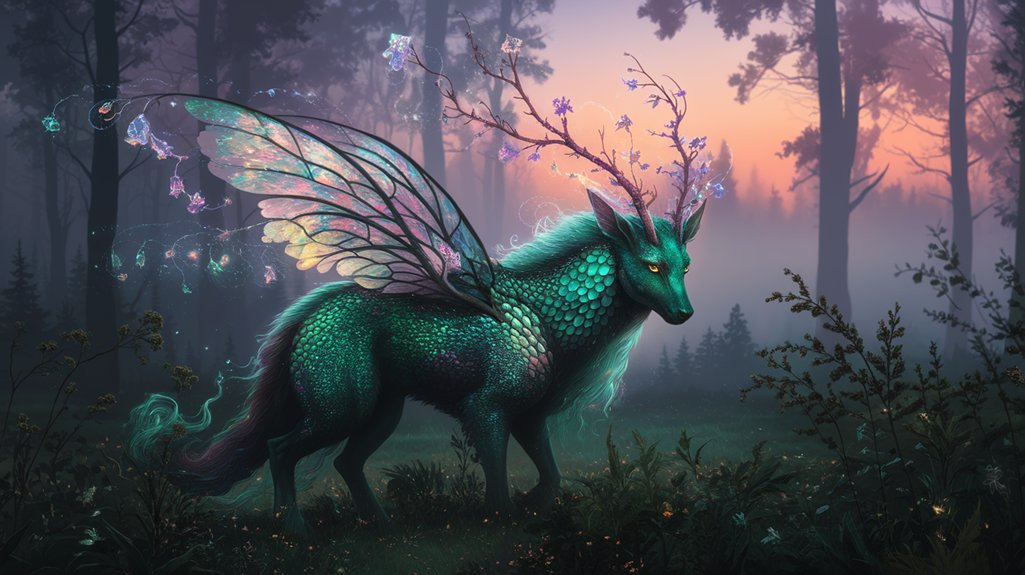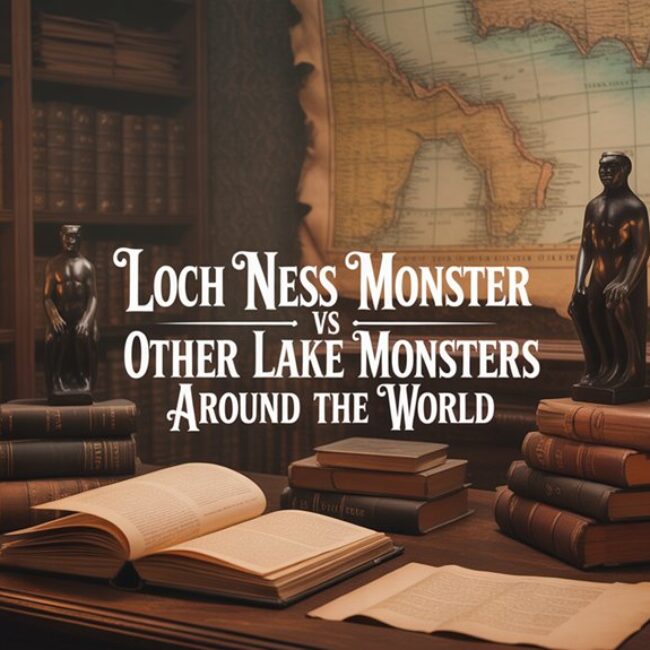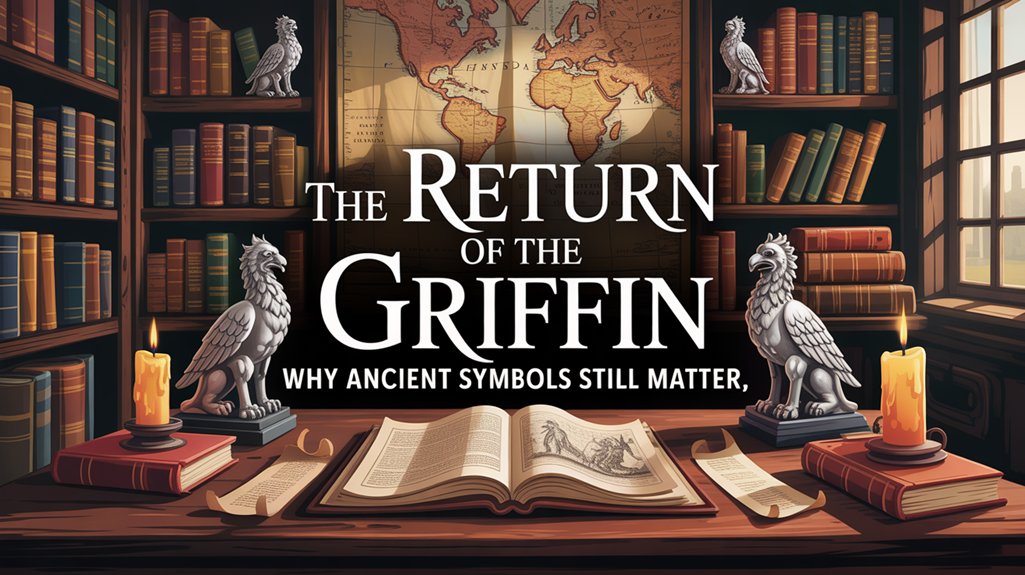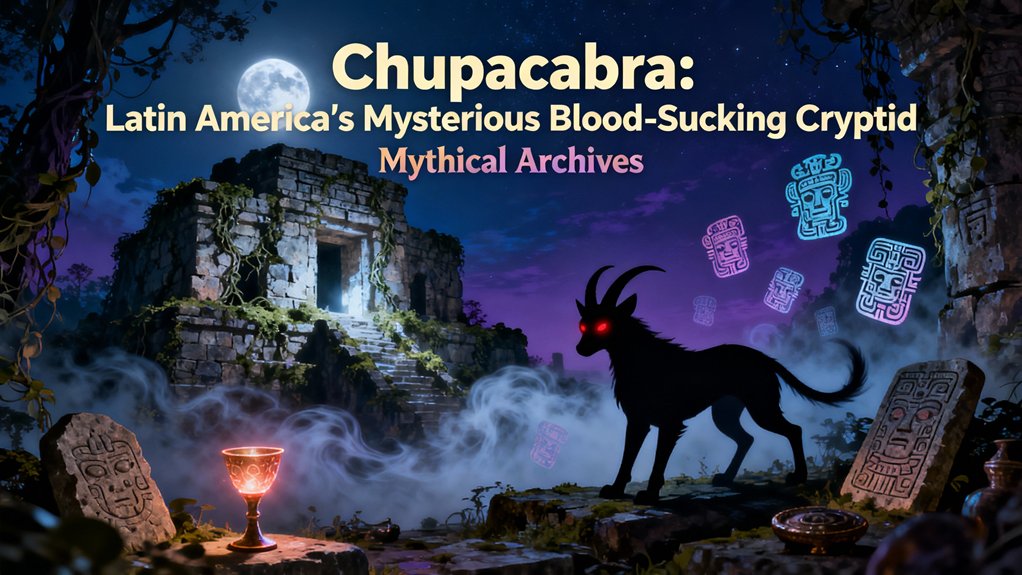
You’ll find the chupacabra emerged from Puerto Rico’s darkness in 1995, when over 150 livestock perished in Canóvanas—their blood meticulously drained through precise puncture wounds. The creature manifests in two chimeric forms: the original bipedal reptilian entity with spinal quills and crimson eyes, and the later canine variant afflicting the American Southwest. This eldritch phenomenon spread through Nicaragua, Chile, Brazil, and Texas, mapping onto Hispanic diaspora routes while embodying ancestral fears of agricultural collapse. The evidence remains contradictory, straddling veterinary pathology and indigenous knowledge—mysteries that await your further examination.
Table of Contents
ToggleKey Takeaways
- The Chupacabra originated in Puerto Rico in 1995, draining over 150 livestock of blood within weeks near Canóvanas.
- Witnesses describe two distinct forms: a bipedal reptilian creature with spinal quills and a hairless, mange-afflicted canine variant.
- The phenomenon spread from Puerto Rico throughout Latin America and reached Texas by 2004, following Hispanic diaspora routes.
- Victims display precise puncture wounds and complete blood drainage, though scientists attribute deaths to diseased coyotes and scavengers.
- The Chupacabra represents Latin American cultural anxieties about agricultural collapse, environmental degradation, and economic displacement.
The Origins: Puerto Rico’s 1995 Outbreak and Early Sightings

Though the chupacabra would eventually spread its shadow across the Americas, the creature’s documented genesis traces to a concentrated series of incidents in Puerto Rico during the sweltering months of 1995.
You’ll find the epicenter in Canóvanas, where residents discovered livestock drained of blood through precise puncture wounds.
These early sightings described something profoundly chimeric: bipedal, reptilian skin, elongated limbs, and those unforgettable spinal quills.
Madelyne Tolentino’s testimony became foundational—she witnessed the eldritch entity outside her window, its eyes radiating an otherworldly luminescence.
What distinguishes Puerto Rico’s outbreak from mere folklore is the sheer concentration: over 150 animals perished within weeks.
The temporal clustering. The consistency of witness descriptions.
You’re examining not scattered myth-making but a documented phenomenon that seized an entire municipality in collective terror, altering rural communities into grounds where the boundary between known zoology and cryptozoological mystery dissolved completely.
Physical Descriptions: Reptilian Monster vs. Hairless Canine
The chupacabra phenomenon manifests through two radically divergent morphological paradigms, each commanding its own geographic and temporal territory within the cryptozoological record. You’ll encounter the original Puerto Rican entity—a bipedal chimeric horror bearing reptilian features: spinal quills, luminescent eyes, elongated claws. This eldritch form dominated early accounts from 1995 onward.
Then emerged the mainland variant.
| Characteristic | Reptilian (PR) | Canine (Mainland) |
|---|---|---|
| Posture | Bipedal, kangaroo-like | Quadrupedal |
| Skin/Fur | Scaled, grayish-green | Hairless, mange-afflicted |
| Eyes | Glowing red orbs | Sunken, yellowish |
The southwestern United States birthed the canine interpretation—mange-ravaged coyotes exhibiting pathological hairlessness, their skeletal frames resembling something otherworldly. These canine traits displaced earlier reptilian morphology in collective consciousness post-2000. Both manifestations share one terrifying constant: exsanguinated livestock bearing precise puncture wounds. The cryptid’s dual nature reflects something deeper—shapeshifting folklore confronting empirical reality.
Geographic Spread: From Caribbean Islands to the American Southwest

When Madelyne Tolentino witnessed the creature outside her Canóvanas home in August 1995, she unknowingly catalyzed a cryptozoological contagion that would metastasize across hemispheres.
Within months, chupacabra sightings erupted throughout Puerto Rico’s central mountains, then leaped oceanic boundaries to contaminate Mexico’s rural provinces by 1996. You’ll trace its eldritch migration through Nicaragua, Chile, Brazil—each nation reporting chimeric variations that reflected indigenous nightmares and colonial anxieties alike.
The phenomenon reached Texas by 2004, where ranchers discovered exsanguinated livestock beneath desert moons.
Arizona, New Mexico, California followed. Geographic variations emerged: Caribbean witnesses described bipedal reptilians with spinal quills, while American Southwest encounters featured hairless, canine aberrations with distended ribcages.
This divergence reveals something profound about folkloric transmission—how ancient terrors adapt, mutate, evolve across cultural membranes.
The creature’s territorial expansion mapped perfectly onto Hispanic diaspora routes, suggesting you’re witnessing not mere cryptid migration, but the restless wandering of collective ancestral dread seeking new soil.
Investigating the Evidence: Dead Livestock and Scientific Explanations
Before scientific instruments could measure the phenomenon, ranchers confronted visceral reality: drained carcasses arrayed across their properties like ritual offerings to something unspeakable.
You’ll find that veterinary pathologists, conducting meticulous livestock analysis throughout Puerto Rico and Mexico, documented peculiar puncture wounds—twin incisions suggesting precision beyond predatory instinct. Blood samples revealed hemoglobin depletion inconsistent with conventional exsanguination patterns, defying naturalistic explanation.
Yet rationalism offers counter-narratives. Mange-afflicted coyotes, their flesh rendered grotesque and chimeric by Sarcoptes scabiei, present eldritch silhouettes at twilight.
Decomposition processes create illusions of blood loss; scavengers inflict postmortem damage. Scientists invoke Occam’s razor, dismissing cryptozoological hypotheses as folklore intersecting with livestock disease.
But you understand: campesinos who’ve witnessed these violations recognize something profound, something existing in those liminal territories where Western empiricism falters.
The evidence remains contradictory, suspended between laboratory data and ancestral knowing—between what microscopes reveal and what moonless nights conceal.
Cultural Impact: The Chupacabra in Media and Modern Folklore
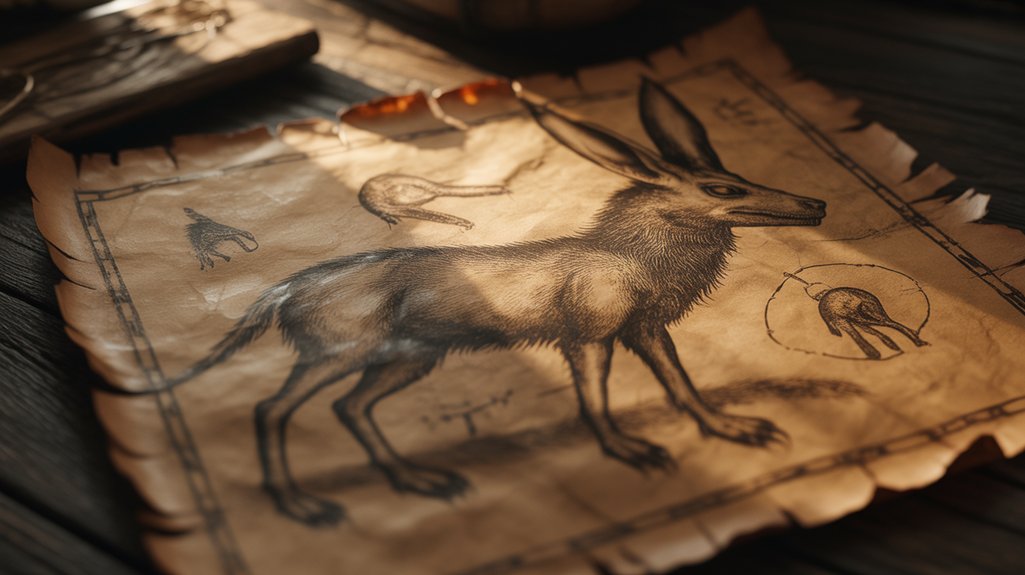
How does mythology colonize consciousness when mass media becomes its vector? You’ve witnessed the chupacabra’s alteration from rural terror to global phenomenon, its chimeric form proliferating through cinema, television, literature.
The creature emerged in 1995 Puerto Rico, yet within months, mythical representations saturated popular culture—appearing in *The X-Files*, spawning B-movies, infiltrating video games and comic books. These media adaptations transmuted authentic campesino testimonies into entertainment commodities, simultaneously preserving and distorting the legend.
Mass media crystallized folklore into commodity, transforming campesino horror into global entertainment while simultaneously preserving and erasing its origins.
The beast’s eldritch image became merchandise, meme, metaphor. Cultural anthropologists recognize this pattern: folklore adapting to technological distribution channels, rural anxieties repackaged for urban consumption.
Yet something persists beyond commercialization. You’ll find the chupacabra functions as contemporary myth-making in real-time, reflecting Latin American identity, economic displacement, colonial legacies. The creature transcends kitsch, embodying genuine fears about agricultural collapse, environmental degradation, marginalized communities confronting inexplicable losses.
Ancient archetype meets modern uncertainty.
Frequently Asked Questions
What Precautions Can Livestock Owners Take to Protect Animals From Chupacabra Attacks?
You’ll need sturdy fencing strategies—reinforced barriers of chain-link or electric wire, stretching deep into earth where eldritch creatures might burrow.
Deploy livestock guardians: donkeys, llamas, or Anatolian shepherds whose ancestral instincts detect chimeric threats lurking beyond firelight’s edge.
Install motion-activated illumination; the predator favors shadow’s embrace.
Document unexplained wounds meticulously, preserving evidence of puncture patterns.
Your sovereignty over land demands vigilance against this cryptozoological enigma that’s haunted rural communities since Puerto Rico’s 1995 emergence.
Are There Any Verified Photographs or Videos of the Chupacabra Creature?
No verified photographic evidence exists—you’ll find only blurred, bewildering cryptid sightings and ambiguous footage.
Each purported image reveals mundane explanations: mangy canids, diseased coyotes bearing eldritch appearances through parasitic affliction.
The chimeric creature persists beyond documentation’s reach, dwelling in testimonial domains where eyewitness accounts supersede technological verification.
You’re confronting a phenomenon residing in liminal spaces, where cultural memory transcends empirical proof.
The chupacabra remains unbound by cameras, existing instead within collective consciousness, ancient fears manifesting through contemporary livestock predation mysteries.
How Does the Chupacabra Compare to Other Cryptids Like Bigfoot or Mothman?
You’ll find Chupacabra myths differ markedly from other cryptids through their chimeric, shape-shifting nature.
While Bigfoot embodies primordial wilderness and Mothman heralds disaster through eldritch prophesy, the chupacabra represents something darker—a modern vampiric entity born from 1990s Puerto Rico.
Cryptid comparisons reveal it’s uniquely recent, culturally specific, lacking the deep folkloric roots of centuries-old phenomena.
It’s tangible, visceral. A predator leaving corpses drained bloodless, demanding your immediate fear rather than reverential wonder.
What Should Someone Do if They Encounter a Suspected Chupacabra?
Should you encounter this chimeric entity, you’re advised to document the experience immediately—photographs, sketches, precise temporal markers.
File formal sighting reports with cryptozoological organizations like the Anomalous Biological Phenomena Registry. Your eyewitness accounts carry scholarly weight.
Maintain distance from the creature’s eldritch presence; retreat calmly without sudden movements.
Note environmental details: electromagnetic disturbances, sulfurous scents, livestock behavior.
You’re contributing to humanity’s understanding of liminal phenomena. Record everything. Your freedom to investigate requires responsibility.
Has Anyone Claimed to Have Captured or Killed a Real Chupacabra?
You’ll find numerous claims pierce the veil between myth and mortality—ranchers from Texas to Nicaragua have presented desiccated carcasses as proof, though DNA analysis invariably reveals mundane origins: mange-afflicted coyotes, diseased dogs.
These chimeric specimens fuel chupacabra legends while disappointing cryptozoologists seeking eldritch truth. Despite hundreds of chupacabra sightings across two decades, no verifiable specimen exists in scientific repositories.
The creature remains tantalizingly ephemeral, dwelling in that liminal space where folklore resists empirical capture, free from taxonomic constraints.
Conclusion
Whether you’re tracking eldritch prints through Puerto Rican hillsides, examining desiccated livestock in Texas scrubland, or parsing folkloric testimony from Michoacán villages, you’ve entered the chupacabra’s liminal territory. Science offers its explanations—mange, predation, mass hysteria. Yet the creature persists in collective consciousness, neither wholly real nor entirely imagined. You’ve witnessed how cryptozoology intersects with cultural identity, how the chimeric becomes authentic through belief, how mystery endures despite rationality’s advance.




